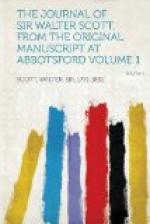FOOTNOTES:
[183] See ante, vol. i. p. 14. Lady Francis Leveson Gower was the eldest daughter of Charles Greville.
[184] Mr. Lockhart writes:—“Among other songs Mrs. Arkwright delighted Sir Walter with her own set of—
’Farewell! farewell! the voice you hear Has left its last soft tone with you; Its next must join the seaward cheer, And shout among the shouting crew,’ etc.
He was sitting by me, at some distance from the lady, and whispered, as she closed, ’Capital words—whose are they? Byron’s, I suppose, but I don’t remember them.’ He was astonished when I told him they were his own in The Pirate. He seemed pleased at the moment, but said next minute, ’You have distressed me—if memory goes, all is up with me, for that was always my strong point.’”—Life, vol. ix. p. 236.
[185] Milton’s L’Allegro, ver. 137, 294.
[186] Afterwards second Earl Powis.
[187] Regarding the Chancery business, see infra, p. 191, n.
[188] Sir Walter had shortly before been one of the contributors to a subscription for Mr. Haydon. The imprisonment from which the subscription released the artist produced, I need scarcely say, the picture mentioned in the Diary.—J.G.L. Haydon died in June 1846. See his Life, 3 vols., 1853, edited by Tom Taylor.
[189] The Duke of Wellington, in after years, said to Lord Mahon, “He had observed on several occasions that Sir Walter was talked down by Croker and Bankes! who forgot that we might have them every day.”—Notes, p. 100.
[190] Romeo and Juliet, Act III. Sc. 1.
[191] Sir W. Knighton, as a Devonshire man, naturally wished to have the portrait painted by Northcote, who was a brother Devonian. Cunningham said of tins picture that the conception was good, and reality given by the introduction of the painter, palette in hand, putting the finishing touch to the head of the poet. “The likenesses were considered good.”—Cunningham’s Lives, vol. vi. p. 124. It was exhibited in 1871 in Edinburgh; its size is 4 ft. 2 in. x 3 ft. 2 in. Mr. David Laing, differing from Allan Cunningham, considered that the picture presented “anything but a fortunate likeness.” Northcote died July 13th, 1831, in his eighty-fifth year.
[192] Act III. Sc. 2.
[193] John Fuller, long M.P. for Surrey, an eccentric character, and looked upon as standing jester to the House of Commons. Scott first met him in Chantrey’s studio in 1820.—See Life, vol. vi. pp. 206, 207. He died in his 77th year, in 1831, without apparently having carried out his intention of editing Foote.
[194] A process in English copyhold law.
[195] Hazlitt said of Northcote, that talking with him was like conversing with the dead: “You see a little old man, pale and fragile, with eyes gleaming like the lights hung in tombs. He seems little better than a ghost, and hangs wavering and trembling on the very verge of life; you would think a breath would blow him away, and yet what fine things he says!”—Conversations.




